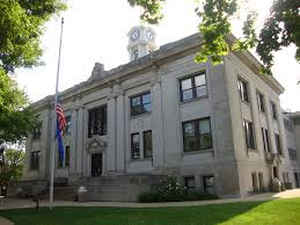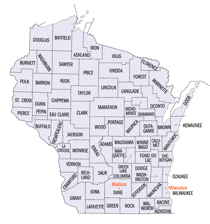Wisconsin Counties
There are seventy-two counties in the state of Wisconsin. Wisconsin became part of the Territory of Michigan and divided into two counties: Brown County in the northeast along Lake Michigan and Crawford County in the southwest along the Mississippi River. The state of Wisconsin was created from Wisconsin Territory on May 29, 1848, with 28 counties.Sauk County, Wisconsin
Sauk County Education, Geography, and History

Sauk County is a county in the state of Wisconsin. It is named after a large village of the Sauk people. Based on the 2010 census, the
population was 61,976. Its county seat and largest city is Baraboo. The county was created in 1840 from Wisconsin Territory and organized in
1844.
Sauk County comprises the Baraboo, WI Micropolitan Statistical Area and is included in the Madison-Janesville-Beloit, WI Combined Statistical
Area.
Etymology - Origin of Sauk County Name
an Indian tribal name - see ante, Ozaukee. It took this name from a large village of that tribe formerly within its borders, for particulars of which, see Wis. Hist. Colls., iii, p. 206; xviii, pp. 282, 335. Although this village was removed before the coming of the American settlers, it left its name to the neighboring Sauk Prairie - Wis. Hist. Colls., i, p. 113.
[Source: Kellogg, Louise Phelps. "Derivation of County Names" in Proceedings of the State Historical Society of Wisconsin for 1909, pages 219-231.]
Demographics:
County QuickFacts: CensusBureau Quick Facts
Sauk County History
Sauk County, created in 1840 as a territorial county, is named for the Sauk Indians. Located in southwest
Wisconsin, the county seat is Baraboo.
John W. Hunt's 1853 Wisconsin Gazetteer
"SAUK, County, is bounded on the north by Adams, on the east by Columbia, on the south by Iowa and Dane, and on the west by La Crosse, Bad Ax, and Richland. It was set off from Crawford in 1839 The boundaries were changed March 6, 1849, and further changed 1853. The seat of justice is at Baraboo, on river of the same name, a few miles southeast from the centre of the county. The number of square miles is about 800. The soil, in every part where cultivation has been attempted, produces well, and seems peculiarly congenial to wheat. The timber, except on the Baraboo Bluffs, is oak in its different varieties. There is an almost inexhaustible body of heavy timber, consisting of sugar maple, elm, basswood, iron wood, hickory, butternut, oak, cherry, &c. The surface of the country is generally undulating - in some places level, in others hilly - presenting, perhaps, as great a variety as any county in the State. Its leading geological formation is old red sand stone. On the higher points there are occasionally found the remains of the carboniferous lime stone, so abundant in the northwest. There are no mines in the county worked at present with any degree of profit, though there are strong indications of copper, and a considerable quantity (five tons) was once dug on Copper Creek, near Reedsburg. The principal streams are the Wisconsin and Baraboo rivers, Honey, Dell and Narrows creeks. The Wisconsin river has as yet only been used for the purpose of navigation, though at present attention is being called to the construction of a dam across it at the Dells. The following is a pretty accurate detail of the hotels, stores, manufactories, &c., in the county: 13 taverns, 22 stores, 5 groceries, 4 drug stores, 7 tailors, 3 distilleries, 1 brewery, 2 steam saw mills, 4 grist mills, 1 foundry, 1 furniture, 1 machine, 9 shoe, 15 blacksmiths, 6 waggon, 4 coopers, 5 tinners, and 3 jewellers shops, 1 carding machine, 6 lath and picket factories, 1 pottery, and 1 tannery; 302 farms, 7 manufactories, and 821 dwellings; 4 district school houses, 3 select schools, and 3 churches. Population in 1840 was 102; 1842, 393; 1846, 1,003; 1847, 2,178; 1850, 4,372.
SAUK.--Population 13,644.
From: Handbook of Wisconsin by S. Silas, 1855
pg. 99-101
This County lies on the north and west of the Wisconsin River. The soil north of the Baraboo River is rich and
well adapted to agriculture. From the Baraboo, south, extending to the Wisconsin, rise the Wisconsin River Bluffs,
precipitous and stony, probably the highest lands in the State. The soil on the bluffs is good, though stony, and
from its position the land will never be held in high estimatson for agricultural purposes. The rest of the County
is forest, openings and prairies. Some portions are level, while others are rolling and hilly, presenting as great a
variety as any other portion of the State. Considerable pine is cut on the Upper Baraboo. There is much good land
unoccupied. The County has not made the progress for four or five years past which many other Counties have.
Baraboo, on the Baraboo River, is the County Seat, and a place of some business. It has a good water power, which
has lain unimproved for two or three years, but arrangements are now being made to use it. Reedsburg is rapidly
improving, many new buildings having been erected the present season. Hamilton is a new village,. Delton and Newport
are both thriving places. Delton about one and a half miles from the Wisconsin River, on Dell Creek,--Newport at the
mouth of the Creek on both sides of the Wisconsin.
Prairie du Sac is on Sac Prairie, on the Wisconsin, the most beautiful village site in the State.
Devil Lake in the Bluffs, is a natural curiosity. Its banks are steep and rocky, rising from 150 to 200 feet. Its
waters have no outlets, are clear, abounding in fish, and its depth has never been ascertained.
The La Crose and Milwaukee Rail Road follows up the north-east side of the Wisconsin River, and crosses into this
County at Newport, a thriving village, where a dam is soon to be thrown across the river, which will make an
excellent water power.
The County is in the Mineral Point land district.
Geography: Land and Water
As reported by the Census Bureau, the county has a total area of 848 square miles (2,197 km2), of which, 838 square miles (2,169 km2) of it is land and 11 square miles (28 km2) of it (1.27%) is water.
Neighboring Counties
Bordering counties are as follows:
- Juneau County - north
- Adams County - northeast
- Columbia County - east
- Dane County - southeast
- Iowa County - south
- Richland County - west
- Vernon County - northwest
Education







